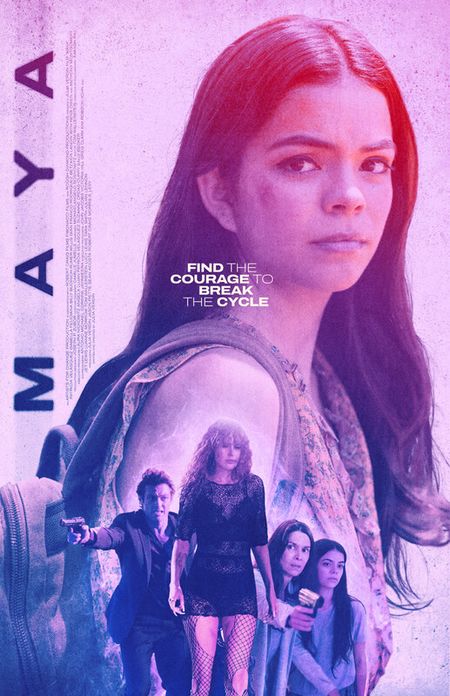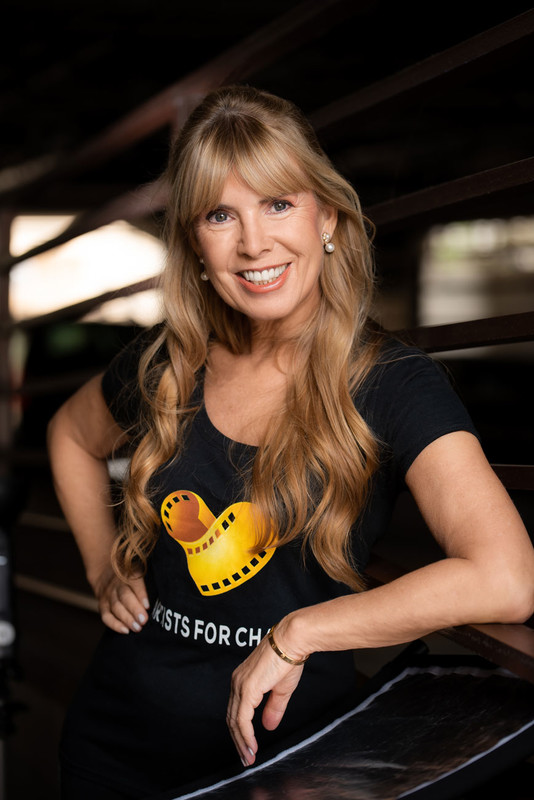|
|
||
|
Pro Tools
FILMFESTIVALS | 24/7 world wide coverageWelcome ! Enjoy the best of both worlds: Film & Festival News, exploring the best of the film festivals community. Launched in 1995, relentlessly connecting films to festivals, documenting and promoting festivals worldwide. We are currently working actively to upgrade this platform, sorry for the inconvenience. For collaboration, editorial contributions, or publicity, please send us an email here. User login |
Maya - Best for Fests
Feature film 1h 44 USA 2023 Profile on filmfestivals.com I Trailer I Synopsis I Director's statement I Crew I
Teenage Maya is raised in a household stricken by her father’s abandonment. Her mom, Camila, is an alcoholic, struggling to make ends meet. Camilla’s boyfriend, Diego, is an abuser who takes advantage of both Camila and Maya. When Maya is followed on social media by an attractive guy named Ray. He responds to her post and seems to genuinely care. Soon Maya begins to chat with him online more about her life and fears. Before long Ray persuades Maya to meet him in person and after a slightly rocky start over him being quite a bit older than his photos, their relationship quickly develops. Ray takes an interest in her problems and dreams and works hard to make Maya feel special. When things escalate at home, Ray encourages Maya to run away with him. Initially spoiled by Ray with new outfits, beauty treatments, and art supplies, Maya slowly begins to realize he has another agenda when he starts using her to make money. Ray persuades her to cooperate by holding everything he has done for her over her head and claiming that he loves her. Maya complies and starts being set up for appointments with Ray’s “clients”. As Ray pimps her out with more clients, Maya finds herself trapped in a sex trafficking ring with no way out. Meanwhile, her mother Camila, falls into despair after losing her daughter. After a near overdose, she agrees to get sober in order to get her daughter back. When Camila gets a call from the police saying that Maya is in their custody, she is overjoyed. However, the trauma that Maya has been through does not make her return as easy as Camila had hoped. Ray is determined not to lose his money-making asset while Camila is intent on not losing her daughter ever again. Can Camila help Maya get back on her feet, or will Maya be forever lost to the dark world she has fallen prey to? Profile on filmfestivals.com I Trailer I Synopsis I Director's statement I Crew I  Julia Verdin: Maya's director statement on 'why make a film on human trafficking'
When I volunteered at a shelter for runaway teens, I was shocked by how many of them were convinced that their traffickers loved them, and that they would come back to rescue them. The whole idea of the Stockholm syndrome type of relationship with a captor has always intrigued me. I was inspired to write Maya after hearing many stories from survivors about the Stockholm type relationships they had with their traffickers. In talking to detectives on trafficking task forces, they noted that it is very difficult getting trafficked teenagers to tell their story and name their pimps so they can be taken off the streets. The refusal to talk about their abusers or cooperate with law enforcement allows the traffickers to continue their lucrative business activities. This is due to the traffickers having convinced their girls that the police are untrustworthy. The victims have been tragically manipulated in a way that has them believing that their trafficker is the only person they can trust and truly cares for them. Former abuse and abuse at home is a common thread seen amongst young victims of trafficking, which has led them to have vulnerabilities that traffickers see and exploit. Kids and teens learn from what they experience at home. In this story, Camila, Maya’s mother, has been abandoned by her husband and is struggling as a single mother. Her loneliness and low self-esteem is what makes her vulnerable to her abusive boyfriend Diego. Diego takes advantage of that and uses Camila, often taking her hard-earned money. As a result, Camila becomes overwhelmed in all areas, and self-medicates with drugs and alcohol, even though she cares deeply for Maya. In order to represent the realities of child trafficking in the most realistic and authentic way possible, I made sure to meet with anti-trafficking groups, trafficking task force detectives and survivors of trafficking. This includes Alan Smyth and Jessica Midkiff of Saving Innocence, Kay Buck of Cast LA, Lieutenant Andre Dawson, who supervised both the LAPD’s Human Trafficking Task Force and the FBI’s Innocence Lost Task Force, and retired LA County Detective Ray Bercini, a leader of the LA Regional Human Trafficking Task Force. I learned that it is becoming increasingly common for traffickers to target and befriend vulnerable youth who have a difficult home life on social media as part of their recruitment strategy. Incorporating that into this film, we see innocent teen Maya get initially contacted by a trafficker via social media. Another heartbreaking aspect of a situation like this that I wanted to explore in detail was the impact of a tragedy like this, not only on the victim themselves, but also their family. In this case, the effect of Maya’s disappearance on her mother, Camila. Many parents work long hours to provide the best social and educational opportunities for their children, but the long hours and consistent absences are a factor in what makes children most vulnerable to traffickers. In the aftermath of a child being trafficking, these parents have to deal with their own feelings of shame and guilt. My goal was to create a commercially viable, social impact thriller that was full of conflict and emotional resonance. I built my story around Maya (16), who is befriended online by a stranger who quickly becomes her confidant. Maya feels abandoned by her mother, who is spending more time with her abusive boyfriend and constantly leaves Maya to pick up the pieces when things go wrong. Beyond the family dynamic, I hope to shed light on the lack of available resources in combating trafficking—an issue both the police and non-profit organizations have to deal with regularly. In terms of production design, each of these characters' environments will have a distinct and telling personality, reflecting their different agendas and influences on Maya. For example, Maya’s apartment will start out drab and uncared for, Maya’s room will be filled with childhood memorabilia, providing a sense of former innocence and evidence of her creativity. Once Camila starts her recovery journey, she starts to take care of her environment and the apartment becomes warm and inviting. The shelter in Oakland will have a frayed look (pointing towards their lack of funding) but also a homey feel, touched by spots of brightness and warmth that the case workers and volunteers have created to help the survivors. The police precinct will be cluttered with case files and missing person reports piled high—indicating the detectives’ lack of time and lack of support. When Maya first arrives in Vegas, I wanted her to be impressed by all the glamor and glitz and then show as she’s pulled deeper to Ray’s world, all gets drabber and a little desaturated as she starts to numb out. In terms of shooting style, my goal was to situate Maya in a world that you want to pluck her right out of. I wanted her to seem very alone and out of place. I worked with my DP to develop a plan and find ways to show Maya’s innermost world with its private agonies and power struggles. We used a lot of push-ins to find the truth on Maya’s face. It was important to find key emotional moments to gut punch the audience, like when we witness the first time Maya is handed over to a client in Vegas. We see her POV of Ray and the client’s face in a distorted way as she, and the audience, sees the ugliness of the situation. I also focused on the parallel journeys of Maya and her mother, Camila. At the beginning of the movie, Maya is very much, albeit unwillingly, her mother’s caretaker. After a near-fatal overdose following Maya’s disappearance and a chance meeting with a stranger, Camila finally becomes willing to get help and get sober. She is then able to share her healing process with Maya once she finally is rescued and be the mother that she has always wanted to be. I was very lucky to be able to cast wonderful actors for all of the roles. Patricia Valesquez was a perfect Camila and really played the layers needed. We had many long talks about mother-daughter relationships prior to our shoot. Funnily enough, she actually has a teenage daughter called Maya. It really helped to create a relationship that felt authentic and real. For Maya, I needed to find an actress who was over 18 but could play 15/16 and have the courage to go to the emotional depths needed for the role. Isabella Feliciana had only done a small part in one film when we cast her and was about to graduate from college. I use a lot of improvising when auditioning to really get a sense of the actors range and I immediately knew she could do this. With Diego, I wanted to make sure that the character felt real, rather than being a stereotype. I had seen Gian Franco Rodriguez’s amazing performance as Victor Hugo in Halston and so immediately knew he would be perfect. Ray was a tough role to cast as I needed an actor that had the charisma to keep a woman on the hook and an inner darkness. Billy Budinich had an energy about him as well as a great look. Kayla was a character that needed to be real and authentic while also having a fragility about them. I had seen Rumer Willis' work on Empire and I knew she had the emotional range required for this role. This was a film that was made thanks to a lot of love and community support. My hope is that it will help educate teenagers and parents as to what trafficking looks like today. I also hope it will open the public’s eyes to being vigilant and reporting it when they see a situation that doesn’t look right. When people join their voices on an issue, change is possible! 22.07.2023 | Maya - Best for Fests's blog Cat. : PEOPLE
|
LinksThe Bulletin Board > The Bulletin Board Blog Following News Interview with EFM (Berlin) Director
Interview with IFTA Chairman (AFM)
Interview with Cannes Marche du Film Director
Filmfestivals.com dailies live coverage from > Live from India
Useful links for the indies: > Big files transfer
+ SUBSCRIBE to the weekly Newsletter DealsAbout Maya - Best for FestsThe EditorUser contributions |























